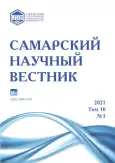Ecological and biological features of annual ornamental plants under pre-winter sowing in a continental climate
- Authors: Sarlaeva M.Y.1, Vasilyeva O.Y.1
-
Affiliations:
- Central Siberian Botanical Garden of Siberian Branch of the Russian Academy of Sciences
- Issue: Vol 10, No 1 (2021)
- Pages: 142-150
- Section: General Biology
- URL: https://journals.rcsi.science/2309-4370/article/view/70430
- DOI: https://doi.org/10.17816/snv2021101122
- ID: 70430
Cite item
Full Text
Abstract
The paper presents the results of a long-term study of biological features of annual ornamental plants species belonging to the ecological group of therophytes included in the bioresource collection USU 44053 and capable of creating a high ornamental effect after pre-winter sowing in the ground. The hydrothermal conditions of the wintering and subsequent vegetation periods are characterized. The accumulation of snow necessary for successful overwintering of seeds is analyzed. Comparative phenospectra of species under different cultivation methods are presented, with an emphasis on achieving the fruiting phase. Examples of naturalization of these species are given, which characterize their high adaptive potential. The most promising species for use in the urbanized environment of the Siberian region are: Amaranthus caudatus L., A. paniculatus L., Brachycome iberidifolia Benth., Calendula officinalis L., Centaurea cyanus L., Clarkia unguiculata Lindl., C. pulchella Pursh., Eschscholzia californica Cham., E. pulchella Cham., Gilia achilleifolia Benth., G. capitata Sims, G. tricolor Benth., Gypsophila elegans M. Bieb., Helichrysum bracteatum (Vent.) Andrews, Iberis umbellata L., Layia elegans Torr. & A. Gray, Rudbeckia hirta L., Salpiglossis sinuata Ruiz & Pav., Schizanthus pinnatus Ruiz & Pav., Vaccaria hispanica (Mill.) Rauschert.
Keywords
Full Text
##article.viewOnOriginalSite##About the authors
Mara Yanovna Sarlaeva
Central Siberian Botanical Garden of Siberian Branch of the Russian Academy of Sciences
Author for correspondence.
Email: inn1311@mail.ru
junior researcher of Ornamental Plants Introduction Laboratory
Russian Federation, NovosibirskOlga Yurievna Vasilyeva
Central Siberian Botanical Garden of Siberian Branch of the Russian Academy of Sciences
Email: vasil.flowers@rambler.ru
doctor of biological sciences, head of Ornamental Plants Introduction Laboratory
Russian Federation, NovosibirskReferences
- Серебрякова Т.И., Воронин Н.С., Еленевский А.Г., Батыгина Т.Б., Шорина Н.И., Савиных Н.П. Ботаника с основами фитоценологии: Анатомия и морфология растений. М.: Академкнига, 2006. 543 с.
- Savinykh N.P., Cheryomushkina V.A. Biomorphology: current status and prospects // Contemporary Problems of Ecology. 2015. Vol. 8 (5). P. 541–549.
- Ханбабаева О.Е. Декоративное садоводство с основами ландшафтного проектирования. М.: ВНИИГиМ, 2015. 394 с.
- Колпакова М.Р., Чиндяева Л.Н., Гончар А.А., Березина Е.А. Ландшафтная архитектура Сибири. Новосибирск: НГУАДИ, 2013. 150 с.
- Вышегуров С.Х., Дымина Е.В., Пономаренко Н.В., Овчинникова Л.А., Пальчикова Е.В., Баяндина И.И., Ксензова Т.Г., Потапова С.С., Васильева О.Ю., Биктимирова Е.В., Быкова С.Л., Сахарова Р.Ф., Ершова М.Е., Снытко О.Н. Дикорастущие и культурные растения Новосибирской области в ландшафтной архитектуре. Новосибирск: ИЦ НГАУ «Золотой колос», 2016. 388 с.
- Агроклиматические ресурсы Новосибирской области. Л.: Гидрометеоиздат, 1976. 155 с.
- Центральный сибирский ботанический сад (справочник-путеводитель) / сост. И.В. Таран, А.А. Храмов. Новосибирск: Наука, 1981. 76 с.
- Бейдеман И.Н. Методика изучения фенологии растений и растительных сообществ. Новосибирск: Наука, 1974. 156 с.
- Вайнагий И.В. О методике изучения семенной продуктивности растений // Ботанический журнал. 1974. Т. 59, № 6. С. 826–830.
- Методические указания по семеноведению интродуцентов. М.: Наука, 1980. 64 с.
- Байкова Е.В. Биоморфологические подходы при интродукции растений в Западной Сибири // Растительный мир Азиатской России. 2015. № 1 (11). С. 108–115.
- Васильева О.Ю., Дорогина О.В., Кубан И.Н., Сарлаева И.Я., Буглова Л.В. Методические аспекты изучения биоресурсных коллекций редких и хозяйственно ценных растений // Садоводство и виноградарство. 2018. № 4 (214). С. 12–18. doi: 10.31676/0235-2591-2018-4-12-18.
- Байкова Е.В. Особенности безрассадной и рассадной культуры декоративных однолетников в лесостепной зоне Западной Сибири // Бюллетень Главного ботанического сада. 1993. № 168. С. 130.
- Зыкова Е.Ю., Шауло Д.Н. Находки во флоре Новосибирской области // Turczaninowia. 2020. № 23 (3). С. 58–66. doi: 10.14258/turczaninowia.23.3.6.
- Шауло Д.Н., Эрст А.С., Шанмак Р.Б., Халбы М.О., Анькова Т.В., Шмаков А.И., Молокова Н.И., Анкипович Е.С. Флористические находки в бассейне Верхнего Енисея (III) // Acta Biologica Sibirica. 2016. Т. 2, № 4. С. 90–94.
- Кравченко В.А., Тимофеева В.В., Рудковская О.А., Фадеева М.А. Сосудистые растения города Беломорска (Республика Карелия) // Труды Карельского научного центра РАН. 2016. № 7. С. 51–71. doi: 10.17076/bg333.
- Жеруков Б.Х., Ханиева И.М., Бекузарова С.А., Ханиев М.Х., Магомедов К.Г., Азикова С.Г., Бозиев А.Л., Кишев А.Ю., Нагаев И.Х., Адаев Н.Л. Способ снижения токсичности почвы при возделывании кукурузы. Патент RU(11) 2 444 879(13) C1 от 26.07.2010.
- Ксю В., Ванг К., Чжан Я., Люа И. Сравнение почвозащитных свойств корневых систем девяти трав в придорожной полосе магистрали в холодном регионе Северо-Восточного Китая // Почвоведение. 2014. № 12. С. 1498–1507. doi: 10.7868/S0032180X14120119.
- Литвинова И.И., Гладков В.А. Получение красивоцветущих декоративных растений, толерантных к высоким концентрациям меди в почвенном покрове мегаполисов // Известия Уфимского научного центра РАН. 2013. № 3. С. 87–90.
- Козлова А.Б., Руденко Ю.В. Ассортимент летников в озеленении Благовещенска и перспективы его расширения // Агропромышленный комплекс: проблемы и перспективы развития: мат-лы всерос. науч.-практ. конф. (Благовещенск, 11 апреля 2018 г.). В 2 ч. Ч. 1. Благовещенск: Изд-во Дальневосточного гос. аграрного ун-та, 2018. С. 44–49.
Supplementary files































